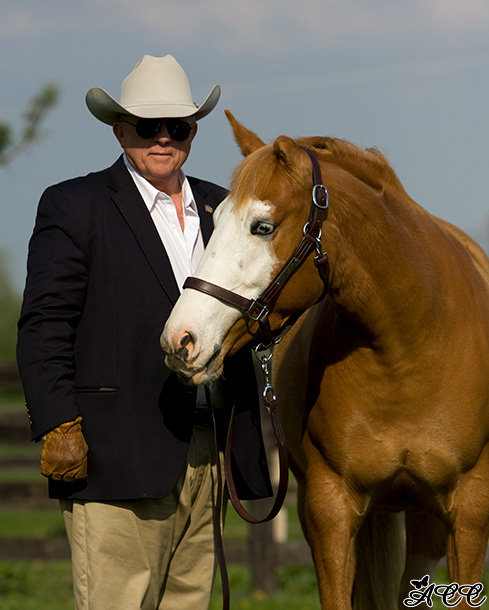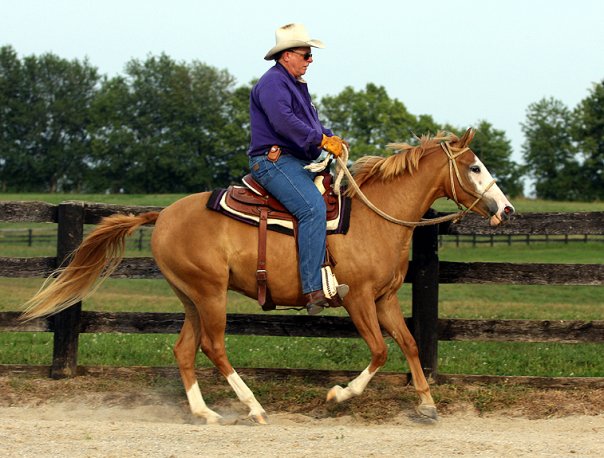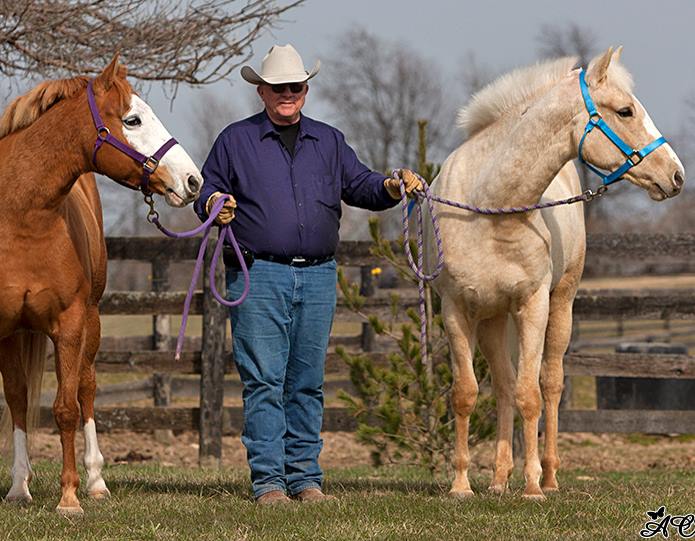
Dr. Reid McLellan is the man who took a little idea to teach grooms how to bandage racehorses, and helped grow it into a program benefitting prisoners in the Thoroughbred Retirement Foundation’s Second Chances program. Photo by Audrey Catherine Crosby McLellan
A racehorse trainer hitting the big time and inmates who are simply doing time, share a common bond that springs from a “little idea” fostered by Dr. Reid McLellan, many moons ago.
McLellan, executive director and lead instructor of the Groom/Elite program— a horsemanship curriculum offered by the Thoroughbred Retirement Foundation in five of nine prisoner/racehorse programs across the country— was rooted in the concept that lessons from horses can transform lives.
“The one thing a horse wants more than anything is peace and harmony and to know they’re not going to get eaten in the next 15 seconds,” McLellan says. “And people want to be able to live with peace and harmony with themselves and their immediate surroundings. Humans can provide this for horses, and horses teach humans how to live that way.”
In his tenure teaching horsemanship classes, which was first offered at Louisiana Tech in the 1970s and 80s, McLellan has seen some amazing things come of the bond between horse and human. Derby bound race trainer Keith Desormeaux graduated the program at Louisiana Tech, he says with just a little pride. And today he is prepping Santa Anita Derby winner Exaggerator for the Kentucky Derby.
And myriad inmates have gotten a fresh start and a new perspective while studying horsemanship in prison.
In this week’s Clubhouse Q&A, McLellan discusses how the idea to teach grooms to bandage horse legs evolved into a curriculum taught in college, on racetracks, and in the Thoroughbred Retirement Foundation’s Second Chances program at prisons.
Q: How did you get your start teaching horsemanship?

When he’s not criss-crossing the country testing inmates on their horsemanship skills, McLellan enjoys a little pony time himself. Photo by Audrey Catherine Crosby McLellan
It started in 1973 when I was hired at Louisiana Tech to implement a horse program that had a racing component. We were the only one at the time with a curriculum that met the guidelines of the state’s racing commission. So our students were licensed after they passed our test, and were able to work with racehorses in training at a half-mile training track at Louisiana Downs. I worked getting it established, and we had some impressive graduates, including Keith Desormeaux, who’s training Exaggerator for the Kentucky Derby now.
I worked there until the program was discontinued in 1988 by a new president, and I took out my trainer’s license and worked at that for eight years. Along the way, I also taught my son Brett, who went on to work with Rachel Alexandra.
Q: Then fate played a hand at the Sam Houston Race Park.
I offered a trainer’s exam prep class at Sam Houston, and Susan O’Hara-Bates, a farm owner, brought four of her clients to take the class. She later asked me to come to her farm and teach them, and I did. After that, she wanted to expand the classes to grooms. She told me at the time that she often found out more from the grooms what was going on with her horses than she did from the assistant trainers and vets because they spend more time with them.
We decided to offer a class at Sam Houston and we advertised that we’d feed them lunch. We were expecting 30 people, 40 at the most. Some people thought there wouldn’t much interest in what we were offering.
But we went ahead with the idea.
 The track kitchen held 80 people, and on the day we offered that class, we had 40 more standing against the walls. We had 120 people, including three trainers and four track administrators. That was the point when the idea for a Groom/Elite crystalized, and Sue O’Hara-Bates became the founder. She harnessed that initiative and convinced the HBPA in Texas to put up funding for the program.
The track kitchen held 80 people, and on the day we offered that class, we had 40 more standing against the walls. We had 120 people, including three trainers and four track administrators. That was the point when the idea for a Groom/Elite crystalized, and Sue O’Hara-Bates became the founder. She harnessed that initiative and convinced the HBPA in Texas to put up funding for the program.
We discussed 14 critical areas that should be covered by the class, and we had an expert in each area write a chapter for the study guide we developed. We had a vet write a chapter on health checking on the horse, and a farrier write a chapter on the foot. I wrote the chapter on bandaging. This all happened in 2001, and the first Groom/Elite class was taught at Lone Star in Texas.
Q: How did you leapfrog to the Thoroughbred Retirement Foundation?
I was teaching a class at Colonial Downs in 2003 after we’d expanded the program out of Texas, and Kip Elser, a trainer who owned Kirkwood Stables in South Carolina saw me teaching a session. At the time, he happened to be the president of the Thoroughbred Retirement Foundation’s South Carolina chapter at Wateree River Correctional Institution. And Kip decided what we were doing was exactly the type of vocational piece they wanted for the inmate program.
In December 2004 they had a grand opening for their first barn at Wateree and their first horses came in June 2005.
After that, we expanded the program to James River Work Center in Virginia, the Central Maryland Correctional Facility, Vandalia Correctional Facility, and Putnamville Correctional Facility. Those five came on board, and we also opened up smaller programs at Plymouth County Sheriff’s Farm and with probationers at the Stanislaw County Sheriff in California.
Q: What is your dream for this program?

McLellan grants a diploma to a successful graduate of the Groom Elite/Second Chances Program at the Thoroughbred Retirement Foundation.
I’d love to see a program where there would be opportunity for all the retired Thoroughbreds to find either a sanctuary home or enter an adoption program where they can be offered a second chance of a life of productivity.
With both the inmates and the horses, I’d like to see them get to a place where they are happy with their lives, where they develop self-esteem, and live productively in peace harmony.
After we graduated that first class at Wateree in March 2006, people were able to see how far the horses and the inmates had come. The horses when they first arrived all had a body score of around 3. And people saw those first photos of the horses when they were so skinny, and how they looked six months later. That, and the clear effect the program had on the men was what spurred me on.
The program has since been very successful in that it helps care for Thoroughbreds, but it also benefits humans, helping a person to change their life. And the donations we’ve taken in, though they may go specifically to buy hay and feed for horses, go toward sustaining a program that changes a person who one day returns to society. There’s no telling how one small donation will spread and grow because of the work it allows us to do with people who are changed men by the time they get out.
—Donations may be made to the Second Chances program at the Thoroughbred Retirement hay drive here:https://trf20546.thankyou4caring.org/Make-A-Gift


This should bevin new york. Whether for inmates or other people.
Fantastic! With out knowing of your work, my six children and I have started a community pony rescue project and nature reserve with some of the same ideas in mind. Nothing is done for profit. We started it with a large settlement we got, but now we rely more and more on prayers and donations. Our aim is to give people, ponies and places a second chance. We believe that when people turn a pony or a place around it helps to turn them around too. These so forgiving rescues have so much to teach us and cheer us up with. Would love to learn more of what you do. The land we are on does not belong to the council/ government but they are determined to take it for development. They have thousands of acres of their own land nearby. Our reserve is visited by blue herons, deer, king fishers, deer, newts, kestrels, owls etc. and we don’t want it to be destroyed. On the pony side we presently have 22 rescue ponies and more and more people with various needs and aspirations come to help. Some ponies have now been rehomed to carefully vetted homes. We hope that people like you who love horses and animals will join our group, support us, share our group and let the government know the world is watching what they are doing. We want ponies, nature and community working together for good not more concrete greed, fracking and development. Please spread the word! We would like everyone the world over to know and be inspired by what, even a very basic project with great passion, can achieve and we need all the support we can to continue the work and legally resist local government threats. We have put everything we have and are in to this project and we now invite horse lovers the world over to stand by our side and fight for what is right. Please join our facebook group ‘ Leigh Rescue Centre &Nature Reserve and share it with all your friends and fellow horse lovers. Thanks and don’t forget to keep up the good work!
I think this a grand program.
I have been wanting to do this is texas.
I goal is to reach them before they get to prison .
Youths at risks with OTTB or retired Warmbloods .
I’m a nurse here in Texas have horses , since I was a gleam in my fathers eye. However I do not own land and not sure how to go about this.